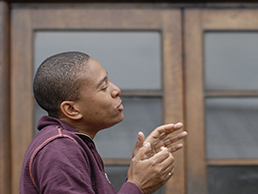
 Sign Language is a visual means of communicating using gestures, facial expression, and body language. Sign Language is used mainly by people who are deaf or have hearing impairments.
Sign Language is a visual means of communicating using gestures, facial expression, and body language. Sign Language is used mainly by people who are deaf or have hearing impairments.
Within Britain the most common form of Sign Language is called British Sign Language (BSL). BSL has it’s own grammatical structure and syntax, as a language it is not dependant nor is it strongly related to spoken English. BSL is the preferred language of around 145,000 people within the UK (2011).
 After a big campaign BSL was finally recognised by the UK government as an official minority language in 2003. This has led to increased funding for the needs of the communication of people who are deaf, and an increased awareness of the language which now has a similar status to that of other minority national languages such as Gaelic and Welsh.
After a big campaign BSL was finally recognised by the UK government as an official minority language in 2003. This has led to increased funding for the needs of the communication of people who are deaf, and an increased awareness of the language which now has a similar status to that of other minority national languages such as Gaelic and Welsh.
To learn more about British Sign Language (BSL) go to https://www.british-sign.co.uk/
British Sign Language Basic 1
Prerequisites
For absolute beginners (ab initio learners) or those with very little knowledge of the language.
Educational Aims
At basic Level 1 the main aims are:
- To develop a basic understanding and an appreciation of British Sign Language (BSL)
- Students will gain basic skills and confidence in production and reception of BSL
- Students will be able to understand signed communication in a given range of topics and answer simple questions about everyday situations
- To introduce students to the background of British Sign Language, the Deaf Community and its culture.
Learning Outcomes
By the end of the Course students will be able to:
| Receptive and production skills: | Understand basic instructions in BSL and take part in a basic factual conversation on a predictable topic. Have the ability to initiate a simple conversation with a deaf person. |
|---|
Programme Structure
The course is delivered in a visual way, (seating will be arranged in a horseshoe shape, so all students will have a clear view of each other). The course will take place during the Michaelmas and Lent terms. It offers 30 hours of classroom tuition in a group, (up to 15 students), and requires the students to study independently (or in pairs) for an additional 30 hours.
Topics
The course introduces students to the following functions and notions:
- Greetings
- Introducing oneself, friends and family
- Describing your nationality, age and profession
- Talking about your daily life; describing routines, hobbies, free time activities, interests and expressing like and dislikes.
- Telling the time
- Going shopping, inquiring about prices, size, quantity etc.
- Describing a home/building, give/ask for address
- Talking about work/study, the timetable
- Understanding information relevant to travel and holidays
- Describing food and drink
Teaching and Learning Methods
The courses are delivered face-to-face. The focus is on visual and dexterous learning, using hands to shape the signs and facial expressions for enthesis. Communicative compliance is required at all times, and students will have the opportunity to work in pairs. Students are expected to practise in their own time so that classroom time is dedicated to real-time face to face communication. Students will be expected to sit next to someone different each week.
Resources
Students will be given handouts each week for reference, in the form of pictures of a person signing topic words. This also includes any excise sheets provided by the class teacher, for individual, pairs and group work.
Assessment Methods
Formative assessment is provided through regular feedback during lessons. At the end of the course the class teacher will question individuals in BSL face-to-face for 5 minutes and the students’ responses will be recorded on video camera for the class teacher to mark.
Student support
The Language Centre has an open-access learning centre (the John Trim Centre) that houses electronic and paper-based language learning and reference materials in more than 180 languages. The Centre also has a dedicated team of Language Learning Advisors whose primary role is to actively support learners.
Managing Teaching Quality and Standards
Student evaluation takes place by one to one questioning with the class teacher, each week. The class teacher assesses the students and an independent BSL instructor will look through the student’s individual video recordings and provides feedback to the class teacher, to decide the student’s final results. Teachers are observed by a Co-ordinator/Director and feedback given.
Further Information
For further information please go to the Language Centre website.
Syllabus:


 The Language Centre
The Language Centre
